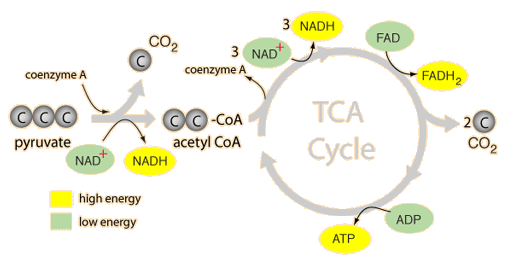What is the first and oldest step in cellular respiration?
Glycolysis is the first pathway in cellular respiration. (choose one answer) what two things make osmosis a special type of diffusion? cellular respiration occurs in both eukaryotic and prokaryotic cells, with most reactions taking place in the cytoplasm of prokaryotes and in the mitochondria of eukaryotes. 3 steps of cellular respiration make us an understanding of how cells get energy from glucose in short. cellular respiration is a set of metabolic reactions and processes that take place in the cells of organisms to convert chemical energy from oxygen molecules or nutrients into adenosine triphosphate (atp), and then release waste products.

Biologists differ somewhat with respect to the names, descriptions, and the number of stages of cellular respiration.
From prokaryotic bacteria and archaeans to eukaryotic protists, fungi, plants, and animals, all living organisms undergo respiration.respiration may refer to any of the three elements of the process. Glycolysis is the initial step of glucose metabolism, which is the common pathway in both aerobic and anaerobic respiration. This is actually the step that produces the most atp, which are about 34. Glycolysis breaks down glucose into pyruvate. Similarly one may ask, what are the 3 steps in cellular respiration? Generating a proton motive force. The following are the four phases of cellular respiration, 1. The first step takes place in the cytoplasm of the cell. Oxidation reactions remove electrons and h+ at same time. Cells can take in and use nutrients. What is the first and oldest step in cellular respiration? The 3 steps of cellular respiration are glycolysis, the krebs cycle, and oxidative phosphorylation. Glycolysis, the krebs cycle, and electron transport.
Both animals and humans breathe, which is a step involved in respiration. cellular respiration refers to the set of biochemical processes involved in the synthesis of adenosine triphosphate, or atp, which provides the essential energy for an organism to. This pathway is anaerobic and takes place in the cytoplasm of the cell. Humans, animals and plants depend on the cycle of cellular respiration and photosynthesis for survival. respiration is the process in which organisms exchange gases between their body cells and the environment.

cellular respiration is a set of metabolic reactions and processes that take place in the cells of organisms to convert chemical energy from oxygen molecules or nutrients into adenosine triphosphate (atp), and then release waste products.
The krebs cycle is the sequence of reactions by which many living cells generate energy throughout an aerobic respirational process. cellular respiration involves 3 major steps: Glucose is oxidized to co 2 and the potential energy is captured by the cell. In both cases, the product of glycolysis is pyruvic acid. Carbon dioxide is a waste product of cellular respiration that comes from the carbon in glucose and the oxygen used in cellular respiration. From prokaryotic bacteria and archaeans to eukaryotic protists, fungi, plants, and animals, all living organisms undergo respiration.respiration may refer to any of the three elements of the process. To make it simpler, one molecule of glucose can generate two molecules of pyruvate. 6 co 2 + 6 h 2o + 36/38 atp b. Professional essay writing service for writing a college essay. The acetyl coa unites with the oxaloacetate to form citrate. (choose one answer) what two things make osmosis a special type of diffusion? respiration is the process in which organisms exchange gases between their body cells and the environment. Would you find proteins inside cells or cells inside proteins?
Glycolysis is the splitting of glucose molecule. Glycolysis krebs cycle electron transport the cellula …. The three main stages of cellular respiration (aerobic) would include glycolysis, the kreb's cycle and the electron transport chain.the krebs cycle takes citric acid which is a derivative of pyruvic acid and converts this through 4 cycles into hydrogen, carbon dioxide and water in the mitochondrial matrix. cellular respiration refers to the set of biochemical processes involved in the synthesis of adenosine triphosphate, or atp, which provides the essential energy for an organism to. cellular respiration has three steps:

Would you find proteins inside cells or cells inside proteins?
Because this part of the cellular respiration pathway is universal, biologists consider it the oldest segment. Draw a diagram of a mitochondrion. What are the 3 main steps of cellular respiration? All of your body's cells rely on atp for normal functioning. Make sure to include all the membranes and compartments of a mitochondrion. Professional essay writing service for writing a college essay. Plants take part in respiration all through their life as the plant cell needs the energy to survive, however, plants breathe differently, through a process known as cellular respiration. cellular respiration is the process in which cells break down glucose, release the stored energy, and use it to make atp. You're supposed to be confused. Identify (list) the two basic types of cells. The first half is known as the "energy requiring" Glycolysis, kreb's cycle and oxidative phosphorylation. Identify (list) the two basic types of cells.
View 3 Main Steps Of Cellular Respiration Pictures. The first stage, glycolysis, produces atp without oxygen. The individual pieces of cellular respiration are more involved, but this a nice overview of the steps and important terms. Draw a diagram of a mitochondrion. Plants take part in respiration all through their life as the plant cell needs the energy to survive, however, plants breathe differently, through a process known as cellular respiration. You're supposed to be confused.






